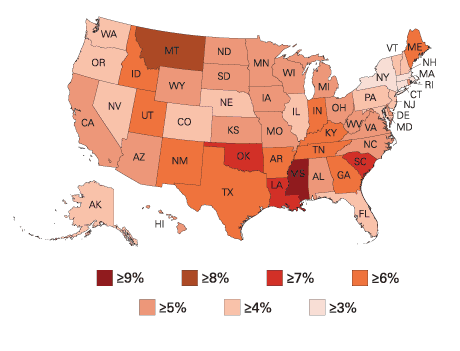
The Natural Resources Defense Council has released a report on Americans’ oil vulnerability. The report ranks states based on what residents spend as a percentage of their income on gasoline, Rhode Island ranks right about in the middle at 27; spending 5.40% or $2214.95 per year on gasoline. Meanwhile Connecticut ranks 50th (or in this case best) at 3.24% – $1824.58 and Massachusetts ranks 48th at 3.66% – $1856.18 (NY, who we have a water border with is 49th, 3.44% – $1654.17).
So all of our neighbors are doing better than us when it comes to spending on fuel. Why is this? Part of course may be that our income levels are lower than in CT, MA, and NY so as we make less, a larger percentage of our income goes towards fuel. However, our actual dollar spending is also higher than our neighbors (in fact, in New England, only Maine spends more dollars on fuel than we do, and Maine is a much larger state).
As a small state with a dense population, we really should be way out in the lead here. Rhode Islanders utter fear of driving any more than 15 minutes in any direction should be enough to move us to the front of the pack, but it is not. Where are we all driving to that is making us spend more on fuel than our neighbors. Do they walk more, do they have closer access to what they need than we do, is it because we are all the time driving to Seekonk to save money on sales tax? Connecticut has a huge population of people who commute to work in New York via train, Boston has very high levels of transit usage due to a robust transit system, is our transit system not up to snuff enough to get people to commute on it?
There is good news, according to the full report  Rhode Island is 13th in the Solutions rankings, meaning we are doing better than most on moving towards reducing oil dependancy.
Rhode Island is 13th in the Solutions rankings, meaning we are doing better than most on moving towards reducing oil dependancy.
What do you think Rhode Island should be doing and needs to do to reduce our dependancy on gasoline?




Our existing transit system is not up to snuff. I’m glad Transit 2020 has a special sub-group looking at Providence and the urban community where most of our population is located.
It’s just we’ve got 11 years to go before all is said and done.
Having lived in both Boston and Providence, this comes as no suprise to me. The best chance for limiting dependence on gas is in and around urban areas. Everyone seems to get around Providence by car. In Boston, I wouldn’t even think about getting in the car during the week. I’d walk or take the subway everywhere I need to go. That is not my experience nor what I have observed of others in Providence. For such a small city, it is surprising how often driving seems like the best option to get from a to b.
The key is a better public transit system (BRT, trolleys, buses), but attention should also be given to pedestrians and cyclists. Parts of Providence are great to bike and walk, but the main transit corridors within the city are so car-centric that it is unpleasant/intimidating to be outside of a metal box.
It could also be due to the number of people driving up to Boston for work. On a personal level I was consuming 20+ gallons a week for years in my various commutes to Boston area when public transit was not an option.
More support for public transportation in the state is vital. We invest less in public transportation options than any neighboring state, with the next to last, Delaware, nearly double our per capita investment at around $67 per capita per year compared to our around $34. While the legislature did increase the gas tax by 2 cents per gallon this year to address persistent budget short falls, the funding formula still creates the catch 22 that if demand increases (people are driving less, buying less gasoline, as happened last summer), there is less revenue for services.
Sierra Club of Rhode Island has good info on the topic at ri.sierraclub.org and as 2010 unfolds, expect to see more activities to support and get involved in as a coalition of groups begin to make transportation choices a key focus.
The following transit ideas could help Rhode Island reduce its dependency on gasoline.
If transit scheduling is frequent and reliable then people will use the system. Extend hours of service hours to 18 to 24 hours a day, seven days a week. Daytime hours should be no more than 10 minutes between buses (or streetcars, if developed); evening hours 15 minutes; late night/early morning hours 20-30 minutes. This kind of scheduling rate is why the New York and San Francisco systems in particular, as well as Boston work so well.
Develop an extensive commuter rail system. Besides the current proposed MBTA extension to Warwick/Wickford, the Kingston/Westerly leg should be added immediately then add or stops stations in between. Other options could be to develop a Blackstone Valley line to Woonsocket, an East Bay line to Bristol, and perhaps a West Warwick/Coventry or Pascoag line, the track right-of-ways are all there. Connecticut success is due not only because of commuters going to New York, but having multiple commuter lines that extend to even small cities, such as Danbury or New London.
Why not develop a single heavy-rail line between Pawtucket/Central Falls and Apponaug with 18 to 20 stations along the Amtrak corridor where the bulk of the dense urban population of metropolitan area lives. There must be 200,000 people within a 5 minute bus ride or drive or a 10 minute walk of that line, plus commercial and industrial centers. Transit 2020’s proposal for a north-south streetcar line following mostly city streets would likely take twice the amount of time to cover roughly the same route as within the Amtrak rail right-of-way.
The key to successfully getting people out of their cars reducing gasoline dependency is to develop a transit system with a focus on frequency of service, maximum number of hours served, speed of service, and maximum connectivity. In many ways Rhode Island is the easiest place to achieve this with compact cities and relatively linear and close suburban areas.
It would make the article more substantive if the following claims were corroborated with actual data:
“””
Connecticut has a huge population of people who commute to work in New York via train, Boston has very high levels of transit usage due to a robust transit system…
“””
specifically:
* what is the “huge population”
* what is “very high levels of transit usage”
I’m down with the enormo-visionary mega-rail concepts (lite rail loop of the Bay running in both directions), but aren’t there some super-simple things we can do to move the needle now?
Of course, I’m on about a radical redesign of the RIPTA route system – which is an utter embarrassment, IMO.
Key routes don’t connect and the entire CONCEPT of connecting from one route to another has this one, stupid solution: Kennedy Plaza.
We really need RIPTA to ask Providence Plan to help them do a big survey of current RIPTA riders to see where they are coming from and where they are going. RIDOT has some super snazzy traffic modeling software that can help develop a new, smart, interconnected route system that can – I AM SO F***ING SURE – deliver more people to more places faster and for less money.
My son – for three years – went from Pawtucket to Wayland Sq. via KP because the 42 (Hope) doesn’t connect with the 40 (Elmgrove).
Not. Efficient.
While I’m obviously a big proponent of overhauling the mass transit system in Rhode Island, I really can’t help noticing this report’s giant, glaring flaw that no one seems to want to point out.
The average income is much lower here than in either Mass, or CT. Massachusetts is full of Boston millionaires, and Connecticut is full of New York millionaires and insurance suits. So, doesn’t it make sense that if they’re making a lot more money to begin with, the percentage of their income spent on gasoline would be smaller? They’re all driving the same amount, possibly more, they just happen to be making a mint, which offsets the percentage. It pretty much destroys the entire premise of the report, which is for rich states to bully poor states into making decisions that they can’t afford, based on fashion trends that happen to have something to do with sustainability.
Perhaps my suggestion of extensive commuter rail service might be a bit overblown, but if you don’t put an idea on the table it will never be discussed. The critical issues with transit in Rhode Island has to do with frequency of service, maximum number of hours served, speed of service, and maximum connectivity no matter what the vehicle type might be.
RIPTA is renowned for infrequency of service. If someone’s bus runs on a half hour schedule and a connecting bus is on a similar schedule, but leave five minutes earlier, it can make a trip unreasonably long. It never made sense that when the bars let out there’s no bus service and if anyone really believes that there’s always a “designated driver,” there’s a bridge for sale in Brooklyn you might be interested in. In Edinburgh, though their bars close much earlier, the last busses leave when the bars close. It’s referred to as the “puke route.” Regarding speed of service multiple entry points from a elevated sidewalk (whether bus or light-rail) along with prepaid trips can speed service. Rail service even the most modest of streetcars are always faster than busses. There have been numerous studies on this. Besides, streetcars and trains have a greater capacity than busses. So with greater capacity the more people are being served by the same bus driver’s or train operator’s salary.
Then again, maybe the simplest solution is for all Rhode Islanders to buy Chevy Volt when they come out next year|that would save a lot of gas.